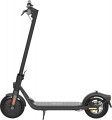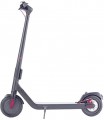Max. load
The maximum weight of the rider that the design of the scooter can withstand without breakdowns and accidents. This moment is partly determined by the age group, and mainly by the materials used in the frame. Note that manufacturers can indicate the maximum load for perfect conditions - when the scooter rides on a perfectly flat surface or even stands still. Therefore, it is worth choosing a model for this parameter with a certain margin. And even more so, you should not exceed the weight indicated in the characteristics - even if the scooter does not break down immediately, this can happen at any time after, which is fraught with accidents and injuries.
Range
The maximum distance that an electric scooter can travel on a single battery charge.
Usually the range is indicated for a flat road and driving only on an electric motor, without the help of a rider. So this indicator is quite conditional, in practice, the distance of the trip may be either less or more, depending on the characteristics of the road and driving style. Nevertheless, according to the claimed range, it is quite possible to estimate the autonomy of different models and compare them with each other.
Note that a
large range (more than 50 km) requires capacious batteries, which affects the dimensions and weight of the device. The real need for such autonomy is not required so often, especially since many electric scooters are quite capable of driving in the usual way, without the use of an electric motor.
Speed modes
The number of speed modes in the electric scooter. By switching between them, the rider has the right to choose the most comfortable pace of the trip and change the upper speed limit bar.
Max. climbing angle
The maximum climbing angle that an electric scooter can overcome on engine power alone, without the help of legs. Models with engines of the same power may differ in this indicator (due to the difference in torque and wheel size).
Note that in the specifications the angle is usually indicated in degrees, while on road signs it is given as a percentage (1% corresponds to a rise of 1 m for every 100 m of horizontal movement). However, this moment is not particularly critical: if you often have to overcome a certain hill, you can clarify its slope by converting percentages into degrees (and vice versa) according to special tables. In addition, if the angle turns out to be too large, nothing prevents you from helping the scooter with your foot, in extreme cases, to overcome the climb on foot.
Wheels
The type and size of wheels used in an electric scooter.
The size is selected by the manufacturer depending on the general purpose of the scooter - whether it is an asphalt road or rough terrain. If we compare similar models with different wheel diameters, then it is worth considering that the larger the wheels (
10" and
larger), the better they handle road unevenness, the higher the cross-country ability and softness of the ride. And small wheels (for example,
8") in turn, they are excellent for smooth asphalt and dynamic driving; they accelerate easily and allow you to make sharp turns.
As for the different types of wheels, there are
polyurethane,
rubber,
inflatable. More details about each:
- Polyurethane. Wheels with solid polyurethane tires. This material provides good shock absorption, high-quality road grip and at the same time good rolling ability; it is resistant to temperature changes and damage, durable, and inexpensive.
— Solid rubber. In this case, we mean wheels with solid rubber tires (inflatable wheels are taken to a separate selection point). In terms of its main characteristics, rubber is similar to the polyurethane described above, and in some respects even surpasses it. Thus, such tires do not make nois
...e, smooth out asphalt roughness well, have excellent grip and provide high braking efficiency. On the other hand, this material is less durable and does not tolerate temperature changes well.
— Rubber inflatable. The most advanced type of wheels found in modern scooters. This type of wheel has an inflatable tire (like a bicycle), which provides excellent shock absorption, tight traction and high maneuverability. The disadvantages of inflatable tires, in addition to the price, include sensitivity to punctures and increased difficulty in maintenance: you need to monitor the pressure and, if necessary, inflate the tire.
— Rubber gel. Tubeless wheels filled with gel are insensitive to minor punctures and cuts. Coming out, the gel in the tire hardens almost instantly upon contact with air, effectively sealing the damaged area. In addition, such wheels require virtually no maintenance - they do not need to be inflated. The disadvantages of gel tires include their high cost and somewhat greater rigidity than inflatable tires (although such wheels are still noticeably superior to rubber wheels in terms of softness).Battery capacity
Battery capacity installed in the electric scooter.
Theoretically, a higher battery capacity allows for a longer range, but in fact, not everything is so clear. Firstly, motors of even the same power can differ in efficiency; secondly, the actual amount of energy stored in the battery depends not only on the capacity in amp-hours but also on the voltage in volts. So this parameter is secondary, and when choosing, it is worth focusing not so much on the battery capacity, but on the directly claimed range. You can compare capacity only for models with similar characteristics and the same supply voltage.
Voltage
In general, this parameter is of secondary importance; in fact, it is needed mainly when looking for a spare / replacement battery or a third-party charger. When choosing, it is worth paying attention to characteristics that are closer to practice - in particular, directly claimed speed and power reserve.
Full charge time
Time to fully charge the battery from zero to 100%.
The more powerful the device, the more capacious batteries it needs and, as a rule, the longer the charging time. In the heaviest models, it can reach 20 hours. However, such indicators are rare - most electric scooters are charged for a maximum of 8-9 hours, which allows you to put the device on charge “from evening to morning”.
Dustproof, waterproof
The degree of protection against dust and moisture provided in the scooter.
This indicator is shown according to the IP standard and in the classic format is indicated by two numbers — for example, IP54. In this case, the first digit means the level of protection against dust and foreign objects, its value can be as follows:
- 4 - protection against foreign objects with a size of 1 mm or more;
- 5 - dust resistance (a small amount of dust can get inside, which does not affect the operation of the device);
- 6 - full dustproof.
The level of water protection, in turn, can be as follows:
- 4 - protection against splashes from any direction, allows you to endure rain without consequences;
- 5 - protection against water jets from any direction, resistance even to severe weather;
In some models, instead of the first digit, "X" is put - for example, IPX4. This means that dust resistance has not been tested, and only moisture resistance should be taken into account.

